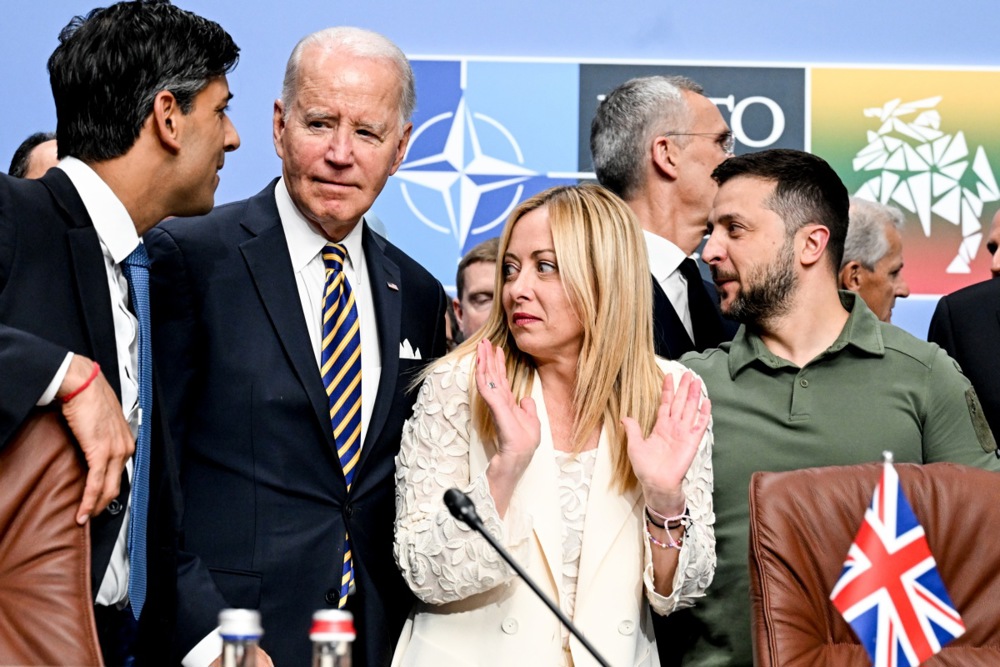As the geometry of international relations alters under the shockwaves emanating from the White House, old assumptions about alliances begin to fray. Like a kind of geopolitical glue, it has been US power that has held the global security system together in the broad form we have known it since 1945.
This has been a world order dominated by a US-led Western Alliance, with the “enemy’s” part played at first by the Soviet Union and now by China — with a brief Fukuyaman interlude of unipolarity after the Cold War.
The deliberate and accelerated disengagement of the US from this model — i.e. the transition to substantive multipolarity — will require a fundamental recalibration of security concepts and strategies across the West, almost from first principles.
There is no substitute for the American power we have known until now.
As such, great chunks of what today passes for our “strategic culture” are rapidly becoming obsolete. Not that those most invested in the current intellectual milieu and who take their talking points from the national security officialdom even recognise it.
With the US role changing, there is much talk about others — especially “Europe”, or individual countries — stepping up to fill the gap. But this is just an initial emotional reaction in response to shock and panic, not a reasoned view.
In time, or quite soon, reality will assert itself in ways that even the most sophisticated “framings” of the strategic situation will not be able to disguise. No one will be able to “compensate” for the US switch away from its traditional responsibilities. Nor have our contemporary societies known a world without the US at the top.
One major part of the intellectual architecture inherited from the age of American dominance and which will now come under conceptual strain is the very notion of “deterrence” — the cornerstone of the defence discourse even today.
Through the Cold War and since, several generations of Western national security professionals have come to reduce the question of national or allied-based defence to the problem of deterrence: how to deter an adversary from attacking.
At its heart is a calculation of military balance between the two opposing forces or blocs. Complex deterrence theories were spun out over the decades, adding various nuances and levels of analysis, starting with nuclear, and even working out whole different types of deterrence strategies (e.g. “by punishment” or “by denial”, etc).
But, fundamentally, it all comes down to a binary question: whether one side (deemed the “aggressor”) thinks it’s stronger than the other, or not.
In other words, “weakness” invites attack, “strength” deters it — this is the basic idea of modern Western defence policy. It sounds like a universal principle, true across the ages, but it is not.
The evidence can be found in the innumerable cases of smaller and weaker states surviving (and often thriving) next to much bigger, assertive powers, throughout history. The binary “deterrence” construct is primarily a product of the East-West ideological struggle of the 20th century where two opposing blocs formed along ideological, not just classic geopolitical, faultlines. Even the word, “deterrence”, is a very modern addition to the strategic lexicon.
The uniqueness of the post-1945 “world order” is worth stressing further. This has been a completely anomalous arrangement of organised human affairs, an extreme aberration at the scale of history. It arose through the chance intersection of three unprecedented historical forces: the invention of nuclear weapons, the onset of US hegemonic power, and the start of a vicious globe-spanning ideological conflict.
All three are now receding as fundamental factors shaping world affairs. US hegemony is effectively ended, even though the US still remains the single strongest power in the world for now.
Ideology is also out: we live in a thoroughly post-ideological world (pseudo-religions like wokeism don’t qualify), indeed even a nihilistic one, at least as far as the West is concerned.
Finally, although nuclear weapons are still around, the strategic balance is now, for the first time, evolving into a tri-polar structure with China’s nuclear buildup. There are other smaller countries with minimal nuclear arsenals build during the Cold War, but for the purposes of global nuclear balance calculations they are marginal.
As the world in which modern deterrence theory arose is vanishing before our eyes, the key question is how to have security without, beyond or outside the deterrence paradigm?
The short answer is to look at how statesmen used to deal with this issue in the multipolar iterations of the world system before 1945. In so doing, we might remember — or discover — that an even more fundamental and basic fact of relations between nations than the balance of strength vs weakness (or “balance of power”) is the balance of interests.
Just because a big country is stronger than its smaller neighbour, that fact doesn’t automatically lead to conquest, even in absence of any particular friendship between them or political alignment — a recent historical example being Finland and the Soviet Union during the Cold War.
A balance-of-interests approach to statecraft and security is grounded in political rather than military calculations. The objective is not to dissuade a potential enemy from attacking by presenting him with a well organised (and often, collective) defence.
Rather, the aim is to shape the international, regional and bilateral political environment in such a way that he does not even develop the intent to attack in the first place because cooperation is more rewarding politically and strategically.
This happens when the prospect of solving any major bilateral issues via diplomacy is more attractive and cheaper than rolling the dice on war. It does require the presence of a serious military factor in the equation on the side of the weaker power, in order to incentivise deals rather than conflicts (again, the post-1940 Finnish model proves the point). But the logic is politics-first, i.e. operating, skilfully, on the opponent’s political calculations.
One reason why we have forgotten this “old” way of doing business is because this kind of approach is usually branded as “appeasement”. And if there is one thing that the national security communities across the West “know” today, is that appeasement is “bad”.
This debate has long devolved into caricature, ever since the Guilty Men thesis which sought to explain the origins of WW2 and managed to make “Munich 1938” into the sole (negative) benchmark of statesmanship in our times.
The Munich Derangement Syndrome is so powerful that it can derail even detente, which is a very different proposition from appeasement, and one actually designed by Kissinger to fit with Cold War deterrence theory.
But there is little room for distinction here, once MDS kicks in. What might a recovery of these methods mean in today’s world, then? Three implications stand out.
Firstly, we are likely to see the breakup of extensive alliance blocs and a shift to smaller, leaner, regional and sub-regional security constructs. NATO is highly vulnerable in this regard, certainly in substance if not in form. And the certain Europeans are already looking for alternatives in their region — see the increasingly clear agenda for the formation of a Northern European security construct from the UK to Finland, but also the recent defence diplomacy in the Balkan region involving Hungary and Serbia, Croatia and others.
The Indo-Pacific will also likely see more fragmentation of this kind, reversing the trend of recent years in which the US sought to align powers across the region into a grand system to contain China.
Secondly, smaller individual states as well as these new smaller groupings devolved from the erstwhile US-led frameworks, will eventually look to engagement and even detente with the likes of Russia and China, as a matter of political and geopolitical reality. Many of these players will remember that a key lesson from history is that intermediate powers can often achieve security and prosperity by playing the big powers off against each other, or engaging in other forms of triangulation and balancing. Nothing but self-imposed moral principles (well-oiled with hypocrisy and lies) prevents this today, but as these have great political force they are not trivial to overturn.
Yet, effective political leaders may well try their hand at doing exactly that, knowing that among their rewards will be the unlocking of new reservoirs of electoral support from voters tired of the old and failed moralistic foreign policies and lies of the Ancien Régimes across the West.
In a world running on a balance of interest logic, political flexibility is at a premium — not rigid alliance commitments. Hungary is the poster child for this approach, as is Turkey. They both retain formal alliance memberships, but interpret their commitments in very loose ways, and often pursue policies which are directly at odds with those of their NATO allies.
This behaviour will likely spread especially in that region, simply as a result of the hollowing out of the deterrence paradigm of security. One aspect of all this that might be worrisome to Kiev is that, once old alliance “loyalties” cease to be the main and unquestioned driver of foreign policy in Eastern Europe, a potentially strong Ukraine could come to be seen (again), rather quickly, as a potential future problem and even threat by its neighbours. Russian diplomacy will not be slow in speculating such dynamics in coming months and years, should they arise.
Thirdly, in a pragmatic balance of interests world, economics can be leveraged as a tool of cooperative, defensive statecraft, rather than being cast as a “security” problem or as an instrument of coercion via sanctions or asset seizures.
The notion of “economic security”, which, among others, includes the task of screening and shutting out investors from “adversary” countries, could be turned on its head. Giving a strong neighbour a stake in your continued prosperity is one way to help avert attacks, as no one wants to kill the goose that lays the golden egg. Singapore knows this, as do many others. For sure, the real world is not always this neat and there are major risks in this approach.
But it is not clear that the approach of trying to securitise the economy in a bid to keep out Chinese IP theft or to stem Russian profits, is or will be, in itself, the path to security and prosperity. It certainly is politically driven, and downstream of the deterrence calculation that underlies the balance of power approach to the world.
None of this should be taken a prescriptive argument. It is too early in a process of historic, structural change, to lay down formulas for how to optimally conduct foreign policy in this new world.
The point, rather, is to remind ourselves that there are far richer and more complex strategic traditions — and for what today we call defence policy — available for use in a multipolar system, than the deterrence-centric universe of the modern Western strategic mind. And whether we like it or not, as the facts of geopolitical life change, so will the solutions to old security problems.
What matters in foreign and defence policy, in the end, is what works — not what makes us “feel” good.






Russia’s vision of a ‘single European security architecture’